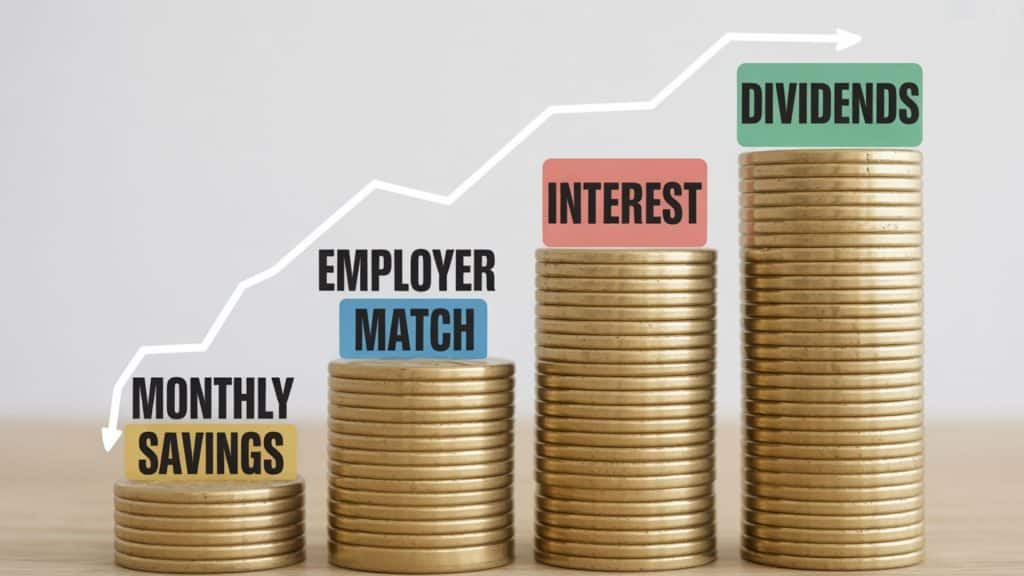Are you lying awake at night wondering if you’ll have enough money to retire comfortably? You’re not alone.
Nearly 40% of Americans have less than $10,000 saved for retirement, and the thought of building a nest egg can feel overwhelming.
But here’s the good news: learning how to save for retirement doesn’t have to be complicated or stressful. Whether you’re 25 or 55, there are proven strategies that can help you build wealth for your golden years.
This blog outlines practical steps to start saving for retirement today, maximize your contributions, and create a personalized plan that suits your unique situation.
Understanding Retirement Accounts
Before exploring specific strategies, let’s establish the foundation of retirement savings. There are several types of accounts designed specifically to help you save for retirement.
401(k) Plans
Most employers offer 401(k) plans, which provide a valuable opportunity for tax-advantaged retirement savings. Here’s what makes them powerful:
- Employer matching: Many companies match a portion of your contributions (free money!)
- Tax benefits: Traditional 401(k)s reduce your current taxable income
- High contribution limits: You can contribute up to $23,000 in 2024 ($30,500 if you’re 50 or older)
- Automatic payroll deduction: Makes saving effortless
Individual Retirement Accounts (IRAs)
IRAs give you more investment control and are perfect if your employer doesn’t offer a 401(k):
- Traditional IRA: Tax-deductible contributions, taxed when you withdraw
- Roth IRA: After-tax contributions, tax-free withdrawals in retirement
- Annual limits: $7,000 in 2024 ($8,000 if you’re 50+)
Understanding these retirement accounts is the first step to making informed choices that will help secure your financial future.
How Much Should You Save for Retirement?
The magic number isn’t one-size-fits-all, but here are some helpful guidelines:
| Age Range | Recommended Savings Rate | Target by Age 65 |
|---|---|---|
| 20s-30s | 10-15% of income | 10-12x annual salary |
| 40s | 15-20% of income | 8-10x annual salary |
| 50s+ | 20-25% of income | 10-12x annual salary |
Don’t panic if you’re behind these numbers. The key is to start where you are and increase gradually.
Smart Strategies to Maximize Your Retirement Savings

Maximizing your retirement savings doesn’t require taking big risks; it just requires making smart, consistent decisions. Use proven techniques to grow your savings more efficiently over time.
1. Take Full Advantage of Employer Matching
This is the closest thing to free money you’ll ever find. If your employer matches 50% of your contributions up to 6% of your salary, contribute at least 6%. Not doing so is like leaving money on the table.
2. Automate Your Savings
Set up automatic transfers to your retirement accounts. When saving happens automatically, you’re less likely to skip contributions or spend that money elsewhere.
3. Increase Contributions Gradually
Start small if necessary, but commit to increasing your contributions by 1-2% annually. Many 401(k) plans offer automatic escalation features that do this for you.
4. Use Tax-Advantaged Accounts Strategically
Consider this approach:
- Contribute enough to your 401(k) to get the full employer match
- Max out your IRA contributions
- Return to your 401(k) to maximize those contributions
- Consider additional options like HSAs if available
Investment Basics for Retirement Savers
Understanding the core principles of retirement investing helps you build a solid financial foundation. Focus on long-term growth, tax advantages, and steady contributions.
Diversification is Key
Don’t put all your eggs in one basket. A well-diversified portfolio typically includes:
- Stocks: Higher growth potential but more volatile
- Bonds: More stable but lower returns
- International investments: Exposure to global markets
- Real estate: Through REITs or real estate funds
Target-Date Funds
These funds automatically adjust your investment mix as you approach retirement. They’re perfect for hands-off investors who want professional management without the complexity.
They gradually shift from growth-focused assets to more conservative ones. This helps reduce risk as you approach your retirement goals.
Keep Costs Low
High fees can eat into your returns over time. Look for low-cost index funds and avoid investments with expense ratios above 1%.
Even a small difference in fees can result in thousands of dollars in costs over the long term. Prioritize efficiency to keep more of your gains.
Common Retirement Saving Mistakes to Avoid
Avoiding common retirement mistakes can make a big difference in your long-term financial security. Here are some of the most important pitfalls to watch out for.
| Mistake | Why It Matters | What to Do Instead |
|---|---|---|
| Starting Too Late | Delaying contributions reduces the time your money has to grow through compounding. | Start as early as possible; even small, regular contributions make a difference. |
| Cashing Out Early | Withdrawing money from retirement accounts early may result in penalties and tax charges. | Keep retirement savings intact unless absolutely necessary. |
| Not Adjusting for Life Changes | Life events like marriage, having children, or career shifts can highly impact your financial plans. | Review your retirement strategy regularly and update it based on major changes. |
| Ignoring Inflation | Inflation reduces the future value of your savings if not managed properly. | Include growth-focused investments to help your money keep pace with rising costs. |
By staying aware of these common missteps, you can make more informed decisions and stay on track toward a more stable and comfortable retirement.
Special Considerations by Life Stage

Your investment strategy should evolve as you progress through different life phases. Each stage brings unique financial goals and risk levels to consider.
In Your 20s and 30s
- Focus on building the habit of saving
- Take advantage of your long-term horizon with growth-oriented investments
- Don’t stress too much about market volatility
In Your 40s and 50s
- Take advantage of catch-up contributions if you’re 50 or older
- Consider working with a financial advisor
- Start thinking about your retirement lifestyle and associated costs
Approaching Retirement
- Gradually shift to more conservative investments
- Calculate your expected retirement expenses
- Consider healthcare costs and long-term care insurance
Action Steps to Start Today
Ready to take control of your retirement future? Here’s your roadmap:
- Calculate your current savings rate and see how it compares to recommendations
- Sign up for your employer’s 401(k) if you haven’t already
- Set up automatic contributions to make saving effortless
- Open an IRA if you need additional savings options
- Review your investment mix to ensure proper diversification
- Set annual reminders to increase contributions and review your progress
Your Path to a Secure Retirement
Learning how to save for retirement might seem daunting at first, but it’s one of the most important financial skills you can develop.
Remember, the best time to start was yesterday, but the second-best time is today. Every dollar you save now has the potential to grow significantly over time thanks to compound interest.
The key is to start with what you can afford, stay consistent, and gradually increase your contributions as your income grows. Your future self will thank you for the decisions you make today.






































